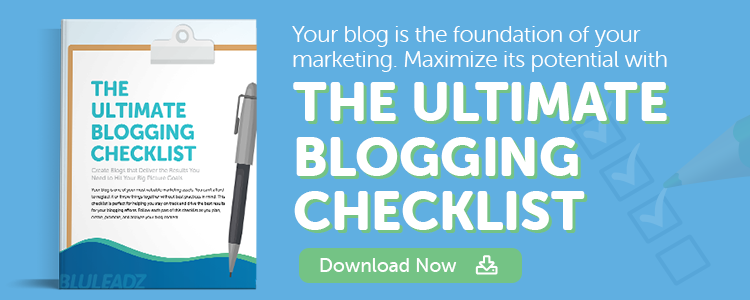When you write the headline and the last line of your blog post, you’ve done half the work.
Why? Your headline is what actually determines whether most readers will, well, read.
And in a world where most people skim, last lines also stand out clearly.
Without a doubt, though, writing an attention-grabbing headline is the best investment you can make in the success of any blog post. Headlines alone – along with a winning headline-building formula – have propelled entire websites to stratospheric success. (Think of Upworthy, for example.)
Now, we’re not suggesting you adopt the wily ways of Upworthy: That site’s meteoric rise was capped by an equally spectacular fall. But what it taught the inbound marketing world is that good headlines are absolutely essential to long-term success in content marketing.
Headlines do all these things:
- They make sure you get attention and engagement when your content is first posted.
- They make it more likely that people will click your content on their social media feeds.
- They allow pieces of content to stand out in search results long after they start to age.
- They give you insight into what words, phrases, and ideas resonate with your audience.
In fact, focusing on great blog headlines is one of the most vital steps to take in looking at your audience not as a loose collection of potential buyers, but as a distinct group whose interests and preferences shape what information they want from you and how they want it.
Luckily, you don’t need a Ph.D. in Blogging to work out an effective headline.
It’s as simple as using these quick headline writing tips:
1. Include a Number
There’s a reason so many blog headlines include a number: It works!
People like to know what they’re getting into before they click on a piece of Web content. A number signals them, giving them a chance to gauge the commitment they’re making. It also lends authority and credence to your words.
After all, you know the Top 5 reasons why cheesecake is delicious.
Numbers are easy to employ and magnetic to your readers, but there are certain things to bear in mind. Always think about what your audience really wants and why they’re on your site in the first place. Very few readers will comb through 47 Reasons Why anything.
Also, be mindful of the kind of claim you’re making and whether you need to ground your content in hard statistics to make it sound plausible.
It’s easy to write about 7 Ways to Manage Your Inbox More Efficiently, but much more difficult to persuasively argue that something is “the best,” “the fastest,” or any other superlative without some hard data or social proof to back it up.
Without delivering on the promise your headline makes, using a number will seem hokey.
2. Use a Catchy Adjective
Adjectives are descriptive words like easy, fast, cheap, and so on.
In blog titles, you’ll probably be using superlatives like easiest, fastest, and cheapest. These terms help your content stand out and clarify to would-be readers why they should choose it over all the other articles they could find on the subject.
If you can come up with 5 Easy Ways to solve a problem most of your ideal customers face every day, you have the makings of a piece of content that will speak directly to their needs.
For an adjective to make your blog headline more compelling, it needs to be both evocative and simple. If you ask 100 people what the word means and why it’s helpful to them, 95 of them should give a very similar answer.
For example, everyone has a different idea of what “brilliant” means, but the thought process that starts when you hear the word “easy” is pretty much the same for most potential readers.
3. Start With a Strong Verb
Verbs are action words like bring, build, create, get, learn, make, and our old favorite save.
Interestingly enough, in the high-powered world of executive job placement, even top C-suite leaders are advised to start virtually every line of their CV with a strong verb. A verb stands out and clarifies what matters most in the sentence, no matter what the context is.
In an excellent blog headline, a verb acquires another superpower: It tells the reader what to do, just like a regular call to action. And as any marketer knows, Web visitors aren’t likely to take that all-important next step unless it’s made explicit – even when they already know what it is.
In other words, people are much more likely to Try These 7 Ways to Manage Your Inbox More Effectively than they are to click the exact same content without the verb.
4. Close With a Promise
The promise usually comes at the end of the headline. You can think of it as an advantage or benefit that sweetens the deal, further emphasizing why your content is worth the reader’s time.
In some cases, the keyword and the promise are the same word or phrase, making things even more efficient. Your promise adds a final punch of potential that should motivate a user to click.
Examples of promises include:
- “... for free.”
- “... faster.”
- “... in less than five minutes.”
- And just about anything “... than ever.”
These 4 headline writing tips will get you well on your way to developing the best blog headlines for your business. Still, don’t forget to leverage the power of data to succeed faster.
So, that’s the scoop on the best blog headlines – in four tips or less. It’s not unusual to spend 30 minutes on headlines and come up with ten alternatives ... so dive in and make it really count!



Rob Steffens
I am the Director of Marketing here at Bluleadz. I'm a huge baseball fan (Go Yankees!). I love spending time with friends and getting some exercise on the Racquetball court.